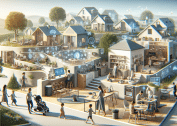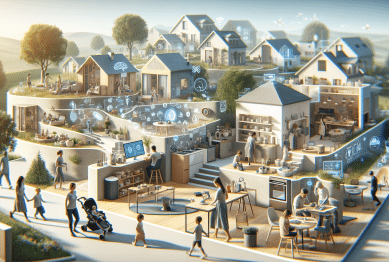In 2025, virtual reality offers unprecedented immersive experiences that go far beyond gaming. With advances in AI-generated environments, multisensory feedback, and immersive entertainment events, VR is reshaping education, healthcare, training, and media. From hospital patients experiencing calming nature simulations to K‑pop fans attending VR concerts in full 3D, the scope of VR’s immersive power is expanding. In this article, you’ll discover the latest trends, practical applications, and how VR’s immersive potential is redefining what “being there” actually means.

Major Trends Driving Immersive VR Experiences
AI-Enhanced Realism and Narrative Depth
Next-gen VR experiences increasingly rely on AI for adaptive storytelling and lifelike environments. AI is used to generate dynamic NPCs, procedural scenes, and immersive narratives that respond to user behavior. This shifts VR from scripted experiences to personalized worlds that evolve in real-time, enhancing presence and emotional engagement .
Multisensory Expansion—Beyond Visuals and Audio
Research is pushing VR into multisensory territory. Projects like the “e‑Taste” device reproduce taste sensations, while temperature-controlled haptic systems simulate touch, smell, and thermal feedback. Such developments allow users to taste virtual food, feel textures, and sense temperature shifts in immersive scenarios.
VR in Education and Training—Learning with Emotional Impact
Studies show immersive VR yields strong educational gains. Learning retention improves by up to 75%, and learner confidence can increase by 275% in corporate and academic settings. Educational VR heightens sense of presence and emotional engagement, producing better learning outcomes than desktop-based equivalents .
Hands-on training in high-risk fields like aviation or healthcare is now reliably done in VR with safety and realism previously unavailable.
Entertainment Reinvented—VR Concerts and Immersive Exhibits
Fans now attend live VR concerts and immersive art exhibits globally. Companies like AmazeVR produce international VR shows featuring K-pop groups and artists like Tomorrow X Together on platforms such as Meta Quest and Apple Vision Pro. Venues such as Sphere in Las Vegas host virtual concerts with 8K visuals and spatial audio from artists like Metallica and Bono . Immersive exhibitions like The Legend of the Titanic in London recreate historic events through VR for powerful emotional resonance.
Why Virtual Reality Offers Unprecedented Immersive Experiences
Heightened Sense of Presence
Compared to desktop or 2D delivery, immersive VR generates significantly greater emotional affect and perceived presence. Studies have documented major increases in presence (d = 0.9) and emotional engagement in immersive VR scenarios. Presence is central to immersion—and it’s what makes VR feel like “being there.”
Emotional and Cognitive Benefits
VR is used effectively in healthcare for stress relief, pain reduction, and rehabilitation. Clinical trials show ten-minute VR sessions offer sustained pain reduction in cancer patients, and VR therapy for seniors reduces loneliness while boosting cognitive engagement. Controlled VR environments also support exposure therapy in mental health settings.
Universal Access to Experiences
VR brings experiences that might otherwise be inaccessible. Seniors in nursing homes can sky-dive, tour the Alps, or attend Broadway shows virtually. These experiences can enhance memory, lift mood, and build social interaction—even remotely.
Practical Applications: Where VR Immersion Matters Most
Education and Skill Development
VR classrooms allow students to explore history, biology, or physics through simulations and interactive environments. Research shows immersive environments motivate learning, critical thinking, and collaboration at higher levels than traditional methods.
Enterprise training—from forklift safety to surgical procedures—now regularly includes VR modules to reduce risk and improve retention. VR training in these fields has shown engagement over 84% and retention near 67%.
Healthcare and Rehabilitation
VR is being used in stroke recovery, Parkinson’s treatment, and chronic pain management. Patients show up to 20–30% improvements in motor function and reduced fall risks and pain levels through guided VR therapy.
Mindfulness-focused VR interventions outperform audio-only formats in raising present-moment awareness and reducing anxiety. Nature-based VR environments can bolster mood and engagement for older adults when access to the outdoors is limited .
Entertainment and Social Engagement
Major brands are expanding VR entertainment. Meta’s upcoming headset “Loma” is launching with exclusive VR content developed with studios like Disney and A24—including Star Wars immersive experiences. This marks a strategic shift toward premium content designed specifically for VR immersion.
Social VR platforms—such as VRChat or AltspaceVR—enhance human connection in virtual worlds, enabling real-time interactions across distance. Immersive, themed arts spaces (e.g. wake-the-tiger amazement parks) bring narrative and sensory design together for radically immersive leisure visits.
Sports fans can now experience live matches from VR seats as if they were in the stadium. Burnley FC will broadcast matches through VR seats to remote viewers via partner Rezzil—a version of immersive fan engagement set to scale with Premier League adoption .
How to Experience VR Immersion: A Starter Guide
- Choose the Right Headset
Devices like the Meta Quest 3, Apple Vision Pro, and Pico 5 offer top-tier wireless immersion with haptics, eye tracking, and spatial audio. - Explore Diverse Content Sources
Delve into immersive training modules, VR concerts via AmazeVR, social worlds (VRChat), mindful nature spaces, and educational apps. - Try Multisensory Experiences
Experiment with apps offering temperature, scent, or touch feedback. For food experiences, look for early “e-Taste” sessions to sense virtual flavors . - Use VR for Wellness
Try mindfulness-focused sessions or nature simulations, especially in limited-access environments like nursing homes or clinical settings. - Adopt with Awareness
Be mindful of potentialcybersickness—move slowly, take breaks, and gradually increase exposure. Individual differences in susceptibility are significant.
Next-Gen Immersive Futures
- The VR market is projected to grow from roughly $44 B in 2024 to $383 B by 2033, reflecting a 27% compound annual growth rate.
- Mainstream adoption within enterprises is accelerating as headsets become lighter, more ergonomic, and more intuitive for remote collaboration and spatial computing.
Conclusion
In 2025, virtual reality offers unprecedented immersive experiences that span education, healthcare, entertainment, and beyond. Powered by AI-generated environments, multisensory feedback, and real-world storytelling, VR delivers presence and emotional resonance unmatched by other media. For professionals, seniors, learners, or fans exploring new content frontiers—VR enables experiences that feel genuinely transformative.
As the tools become more accessible and content more varied, VR’s immersive promise is becoming reality—for anyone ready to step into a richer world.
References
- TechCrunch (2025) – “Apple’s Vision Pro 2 and the Race for Mixed Reality Dominance”
https://techcrunch.com/2025/07/25/apple-vision-pro-2-launch - Forbes (2025) – “Why Virtual Reality Is The Future Of Remote Work And Corporate Training”
https://www.forbes.com/sites/forbestechcouncil/2025/06/12/why-vr-is-the-future-of-corporate-training - Scientific American (2024) – “The Brain in VR: How Immersive Tech Affects Human Cognition”
https://www.scientificamerican.com/article/the-brain-in-vr-2024









